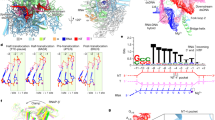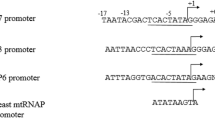Summary
For studying the termination activity of inverted nutL site of bacteriophage lambda, we have constructed a plasmid carrying the nutL fragment oriented reversely with respect to cloned lambda promoter p′R-directed transcription. The results of in vitro transcription on this plasmid template and S1 mapping assay reveal that the termination of p′R-promoted transcription at inverted nutL site is a rho-independent event. This nutL terminator shares several features with the other known sites of transcription termination, including (i) a uridine-rich 3′ terminal RNA sequences, — UUAAUUUUU-OH, (ii) a GC-rich region in the DNA immediately preceding the site of termination, (iii) a region of dyad symmetry in the DNA which, in transcript, is capable of forming a stable hairpin containing four GC base pairs and one AU base pair in its stem.
Similar content being viewed by others
References
Birnboim HC, Doly J (1979) A rapid alkaline extraction procedure for screening recombinant plasmid DNA. Nucl Acids Res 7:1513–1523
Botchan P (1976) An EM comparison of transcription on linear and superhelical DNA. J Mol Biol 105:161–176
Calva E, Burgess RR (1980) Characterization of rho-dependent termination site within the cro gene of bacteriophage lambda. J Biol Chem 255:11017–11022
Calva E, Rosenvold EC, Szybalski W, Burgess RR (1980) Analysis of the in vitro synthesis of 5′-32P-labeled transcript from coliphage lambda by gel electrophoresis, RNA-DNA hybridization and RNase T1 digestion. J Biol Chem 255:11011–11016
Drahos D, Szybalski W (1981) Antitermination and termination functions of the cloned nutL, N and t L1 modules of coliphage lambda. Gene 16:261–273
Franklin NC, Bennett GN (1979) The N protein of bacteriophage lambda, defined by its DNA sequence, is highly basic. Gene 8:107–119
Herskowitz I, Hagan D (1980) The lysis-lysogeny decision of phage λ: Explicit programming and responsiveness. Annu Rev Genet 14:399–445
Honigman A, Hu SL, Szybalski W (1979) Regulation of integration by coliphage λ: Activation of int transcription by the cII and cIII proteins. Virology 92:542–556
Ineichen K, Shepherd JCW, Bickle TA (1981) The DNA sequence of the phage lambda genome between p L and the gene bet. Nucl Acids Res 9:4639–4653
Kubo M, Kano Y, Nakamura H, Nagata A, Inamoto F (1979) In vivo enhancement of general and specific transcription in Escherichia coli by DNA gyrase activity. Gene 7:153–171
Lozeron HA, Dahlberg JE, Szybalski W (1976) Processing of the major leftward mRNA of coliphage lambda. Virology 71:262–277
Luk KC, Szybalski W (1982) Transcription termination: Sequence and function of the rho-independent t L3 terminator in the major leftward operon of bacteriophage lambda. Gene 17:247–258
Mandel M, Higa A (1970) Calcium-dependent bacteriophage DNA infection. J Mol Biol 53:159–162
Martin F, Tinoco I (1980) DNA-RNA hybrid duplexes containing oligo (dA:rU) sequences are exceptionally unstable and may facilitate termination of transcription. Nucl Acids Res 8:2295–2300
Maxam A, Gilbert W (1980) Sequencing end-labeled DNA with base-specific chemical cleavages. In: Grossman L, Moldave K (eds) Methods in enzymology, vol 65. Academic Press, New York, p 499
McKenney K, Shimatake H, Court D, Schmeissner V, Brady C, Rosenberg M (1981) A system to study promoter and terminator signals recognized by Escherichia coli RNA polymerase. In: Chirijian JG, Papas TS (eds) Gene amplification and analysis, vol II: Analysis of nucleic acids by enzymatic methods. Elsevier-North Holland, New York, p 383
Platt T (1981) Termination of transcription and its regulation in the tryptophan operon of E. coli. Cell 24:10–23
Rosenberg M, Court D (1979) Regulatory sequences involved in the promotion and termination of RNA transcription. Annu Rev Genet 13:319–353
Rosenberg M, Court D, Wulff DL, Shimatake H, Brady C (1978) The relation between function and DNA sequence in an intercistronic regulatory region in phage λ. Nature 272:414–423
Rosenvold EC, Calva E, Burgess RR, Szybalski W (1980) In vitro transcription from the b2 region of bacteriophage λ. Virology 107:476–487
Salstrom JC, Szybalski W (1978) Coliphage λ nutL−: A unique class of mutants defective in the site of N utilization for antitermination of leftward transcription. J Mol Biol 124:195–221
Schwarz E, Scherer G, Hobom G, Kossel H (1978) Nucleotide sequence of cro, cII, and part of the O gene in phage λ DNA. Nature 272:410–414
Southern EM (1975) Detection of specific sequences among DNA fragments separated by gel electrophoresis. J Mol Biol 98:503–518
Szybalski EH, Szybalski W (1979) A comprehensive molecular map of bacteriophage lambda. Gene 7:217–270
Author information
Authors and Affiliations
Additional information
Communicated by E. Bautz
Rights and permissions
About this article
Cite this article
Luk, K.C. A rho-independent termination caused by the cloned inverted nut L site of phage lambda. Molec Gen Genet 187, 320–325 (1982). https://doi.org/10.1007/BF00331137
Received:
Issue Date:
DOI: https://doi.org/10.1007/BF00331137




